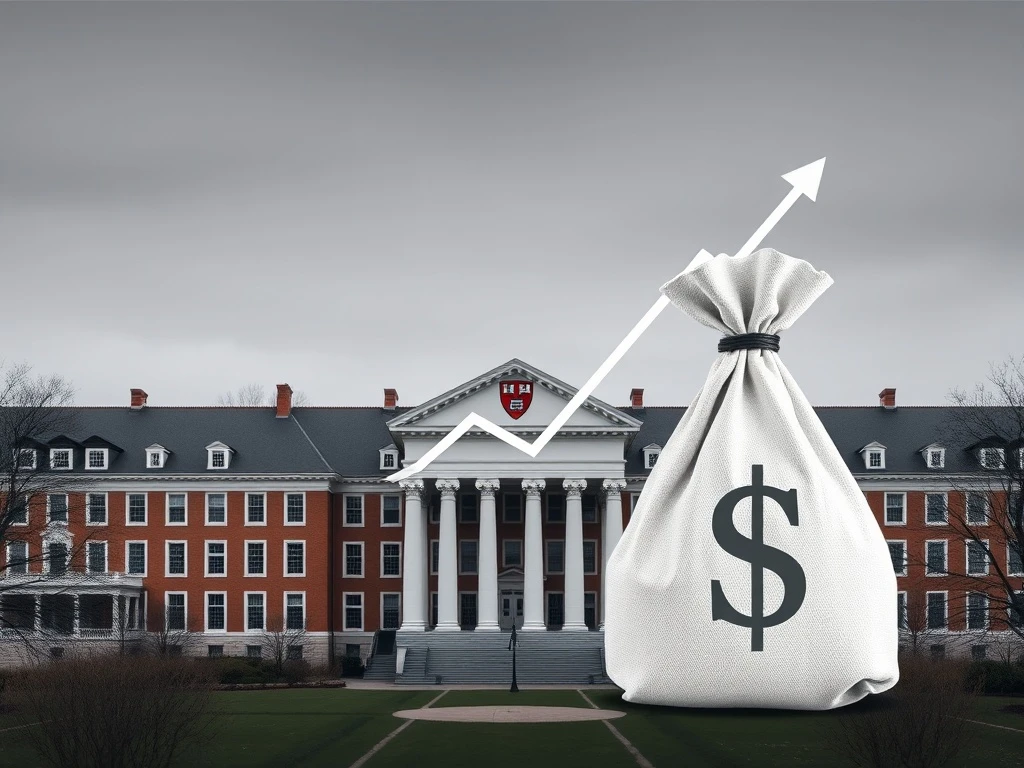Harvard University, a beacon of academic excellence, faces a significant financial challenge. Recent analysis suggests its substantial endowment could shrink by as much as 40%. This alarming forecast stems directly from potential White House policies. Such a reduction would reshape the university’s financial landscape. It could also impact its future operations and global standing. This article explores the analysis, its implications, and the broader context for the **Harvard Endowment**.
Understanding the Harvard Endowment’s Vulnerability
The **Harvard Endowment** is the largest university endowment in the world. It provides crucial financial support for Harvard University’s academic mission. This includes funding for scholarships, faculty salaries, research initiatives, and campus operations. The endowment operates much like a perpetual fund. It invests donations and accumulates returns over time. However, it also faces market volatility and economic shifts. Its sheer size, while a strength, also makes it highly sensitive to policy changes.
The endowment’s investment strategy is diverse. It includes public equities, private equity, hedge funds, real estate, and natural resources. This diversification aims to mitigate risk. However, broad economic shifts or targeted government policies can still have profound effects. For instance, changes in tax laws or investment regulations can directly impact investment returns. Furthermore, global trade policies can affect international markets where the endowment holds significant assets. Thus, external factors play a critical role in its health.
White House Policies: A Deep Dive into Potential Impacts on the Harvard Endowment
An independent analysis highlights specific White House policies as potential catalysts for the projected shrink. These policies could influence the **Harvard Endowment** through several channels. First, proposed tax reforms might significantly alter the financial landscape for large endowments. For example, new taxes on investment gains or changes to charitable giving incentives could reduce both incoming funds and investment returns. This directly impacts the endowment’s growth trajectory.
Second, regulatory changes could impose new compliance burdens or restrict certain investment strategies. Increased oversight or new rules for private equity and hedge funds might limit the endowment’s ability to generate high returns. Third, shifts in trade policy or international relations could destabilize global markets. Since the **Harvard Endowment** has a significant portion of its assets invested globally, such instability could lead to substantial losses. Therefore, these policy areas represent considerable risks.

The Staggering 40% Shrink: Implications for Harvard’s Future
A 40% reduction in the **Harvard Endowment** would translate into billions of dollars in lost capital. This level of decline would have profound and far-reaching implications for the university. Firstly, it would severely limit Harvard’s capacity to offer financial aid. Many students rely on these scholarships. A reduction could make a Harvard education inaccessible for talented individuals from lower-income backgrounds. Consequently, this would diminish the university’s commitment to diversity and access.
Secondly, research initiatives would face significant cuts. Harvard is a global leader in scientific, medical, and social research. Reduced funding could slow down or halt critical projects. This might impact advancements in various fields. Thirdly, faculty recruitment and retention could suffer. Competitive salaries and research support attract top academics. A smaller endowment might compromise Harvard’s ability to retain its world-class faculty. Furthermore, campus infrastructure projects might be delayed or canceled. This affects the learning and working environment for thousands.
Beyond Financial Loss: Academic and Social Ramifications for the Harvard Endowment
The impact extends beyond mere financial figures. A diminished **Harvard Endowment** could affect the university’s academic standing globally. Its ability to innovate and lead in various disciplines might lessen. Furthermore, the broader ecosystem of higher education could feel a ripple effect. Harvard often sets benchmarks for other institutions. Its struggles could signal challenges for the entire sector. Therefore, the implications are not just institutional but societal.
The analysis also suggests a potential decline in philanthropic giving. Economic uncertainty, coupled with changes in tax incentives, might deter large donors. This would create a double blow for the endowment. Thus, the long-term health of the institution depends on multiple factors. These factors include both investment performance and sustained donor support. Preserving the endowment’s strength is vital for Harvard’s continued leadership.
Navigating Economic Headwinds: Strategies for Endowment Protection
Faced with such a significant threat, the managers of the **Harvard Endowment** would need to adopt robust strategies. Diversification remains a key principle. However, deeper analysis of asset allocation might be necessary. This includes assessing the risk exposure to specific policy-sensitive sectors. Secondly, active engagement with policymakers could become crucial. Universities often lobby for favorable policies. This could involve advocating against measures detrimental to endowments.
Thirdly, operational efficiency within the university could be prioritized. Reducing administrative costs or finding innovative ways to deliver services might help offset some financial shortfalls. Furthermore, exploring alternative funding sources beyond the traditional endowment could be considered. This might involve new partnerships or revenue-generating ventures. Therefore, a multi-faceted approach is essential for resilience.
Broader Echoes: How Other Institutions Might Be Affected by Harvard Endowment Challenges
The potential challenges facing the **Harvard Endowment** are not isolated. Many other university endowments across the United States operate under similar economic and policy frameworks. While Harvard’s endowment is exceptionally large, smaller institutions also rely heavily on their financial reserves. Consequently, if White House policies negatively impact Harvard, they could create a ripple effect across the entire higher education sector. This could lead to widespread financial strain for universities nationwide.
Smaller endowments, with less diversification, might be even more vulnerable. They often lack the scale to absorb significant losses. This could force them to make difficult decisions. These decisions might include cutting academic programs, increasing tuition fees, or reducing student support services. Thus, the implications extend far beyond a single institution. They touch upon the accessibility and quality of higher education for millions of students. Policymakers must consider these broader impacts.
In conclusion, the analysis forecasting a potential 40% shrink in the **Harvard Endowment** due to White House policies presents a serious concern. This prospect highlights the intricate link between government action and institutional financial health. Such a reduction would significantly impede Harvard’s ability to fulfill its mission. It would also set a concerning precedent for other educational institutions. Proactive measures and careful policy considerations are therefore paramount to safeguard the future of higher education funding.
Frequently Asked Questions (FAQs)
What is the Harvard Endowment?
The Harvard Endowment is the largest university endowment globally. It is a permanent pool of capital invested to support Harvard University’s academic and research missions indefinitely. It funds various university activities, including student financial aid, faculty salaries, and groundbreaking research projects.
Which White House policies could impact the Harvard Endowment?
Analysis suggests that various policies could have an impact. These include changes to tax laws affecting investment gains or charitable donations, new regulations on investment strategies (like those for private equity or hedge funds), and shifts in international trade policies that affect global markets where the endowment invests.
What would a 40% shrink in the Harvard Endowment mean for the university?
A 40% reduction would signify a loss of billions of dollars. This would severely limit financial aid, potentially making education less accessible. It could also force cuts in critical research, affect faculty recruitment and retention, and delay essential campus infrastructure improvements. Ultimately, it would diminish Harvard’s capacity for excellence.
How might other university endowments be affected by these policies?
Other university endowments could face similar challenges. While Harvard’s endowment is unique in size, the policies impacting it could also affect smaller endowments. These institutions might be even more vulnerable to financial strain, potentially leading to widespread cuts in programs, increased tuition, and reduced student support across the higher education sector.
What steps can endowments take to mitigate these risks?
Endowments can adopt several strategies. These include reassessing and further diversifying investment portfolios to reduce policy-sensitive exposures. They can also engage in advocacy efforts with policymakers. Additionally, universities can focus on operational efficiency and explore new, alternative funding sources to build financial resilience against external shocks.
























